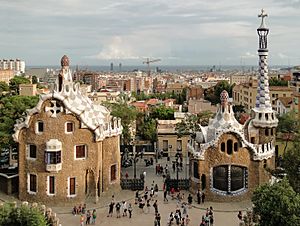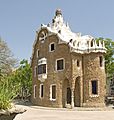Park Güell facts for kids
Park Güell is a famous public park with beautiful gardens and unique buildings. You can find it on Carmelo Hill in the city of Barcelona, Spain. This hill is part of the Sierra de Collserola mountain range. The park itself is located in a neighborhood called La Salut, which is in the Gràcia district of Barcelona.
A businessman named Eusebi Güell wanted to create a special urban park. He asked the famous architect Antoni Gaudí to design it. Gaudí created the park in the Catalonian modernism style, which is known for its wavy lines and natural shapes. The park was built between 1900 and 1914. It officially opened to the public as a park in 1926.
Because of its amazing design, UNESCO named Park Güell a World Heritage Site in 1984. This means it's a very important place that should be protected for everyone to enjoy. In 2007, Park Güell was also chosen as one of the 100 finalists for the "12 Treasures of Spain."
Contents
Exploring Park Güell's Design
Park Güell is famous for its unique and artistic features. Gaudí used many natural shapes and bright colors in his designs. He wanted the park to feel like a magical place that blended with nature.
The Main Entrance and Dragon
When you enter Park Güell, you'll see two interesting buildings that look like gingerbread houses. These were originally meant for the park keeper and a reception area. The main entrance also features a famous mosaic salamander, often called "el drac" (the dragon). This colorful creature is a popular spot for photos.
The Hypostyle Room and Terrace
Above the entrance, there's a large area called the Hypostyle Room. It has many columns that look like tree trunks. These columns support the main terrace above. The ceiling of this room is covered with beautiful mosaic patterns.
The main terrace is a huge open space with a long, winding bench around its edge. This bench is also covered in colorful mosaics made from broken tiles, a technique called trencadís. Gaudí designed the bench so that people could talk privately, even in a big crowd. He also added small bumps to help it dry quickly after rain.
Pathways and Viaducts
Gaudí designed the park's roads and walkways to fit perfectly with the natural landscape. He used stones from the park itself to build them. Some paths are like covered walkways, with columns that lean to support the roads above. You can even find little "bird nests" built into the walls of these walkways, showing Gaudí's love for nature.
There are also three viaducts (bridges) in the park. Gaudí built these so that carriages could easily travel from the entrance to the top of the mountain, where the "Turó de Tres Creus" (Hill of Three Crosses) is located. Today, these viaducts still help visitors explore the park.
Images for kids
-
One of the three viaducts located within the park. Originally created by Antoni Gaudí to allow carriages to easily facilitate the transportation of visitors from the park's entrance to the "Turó de Tres Crosses" which can be found on the top of the mountain, these viaducts continue to allow guests to travel throughout the park.
-
Colonnaded pathway where the road projects out from the hillside, with the vaulting forming a retaining wall which curves over to support the road, and transmits the load onto sloping columns.
See also
 In Spanish: Parque Güell para niños
In Spanish: Parque Güell para niños























